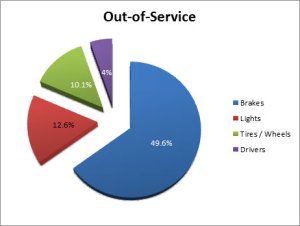Commercial Motor Vehicle road-side inspections are a part of life for truck drivers. The last think you want is to be placed out-of-service for failing an inspection; losing time on the road is never good. This week, from September 7th through September 13th, will see over 30,000 CMV inspections for Brake Safety Week.
What is Brake Safety Week?
 Brake Safety Week is sponsored by the Commercial Vehicle Safety Alliance (CVSA), in coordination with the Federal Motor Carrier Safety Administration (FMCSA), to encourage safe roads and safe driving. The CVSA was created to provide information and direction to enforcement agencies, the trucking industry, and policy makers. Brake Safety Week is a part of the CVSA’s Operation Airbrake Program, which has been educating truck drivers and mechanics about brake safety and the importance of proper driver inspections since 1998.
Brake Safety Week is sponsored by the Commercial Vehicle Safety Alliance (CVSA), in coordination with the Federal Motor Carrier Safety Administration (FMCSA), to encourage safe roads and safe driving. The CVSA was created to provide information and direction to enforcement agencies, the trucking industry, and policy makers. Brake Safety Week is a part of the CVSA’s Operation Airbrake Program, which has been educating truck drivers and mechanics about brake safety and the importance of proper driver inspections since 1998.
In 2012, 21,255 CMV’s were inspected during Brake Safety Week, and 15% of these were placed out-of-service. Last year, roughly 20,000 inspections occurred, but only about 9% of the inspected vehicles were placed out-of-service. Hopefully this year, that percentage will be even less. For general roadside inspections, about half of all out-of-service orders are related to a brake error or mechanical problem.
What Happens During Brake Safety Week?
State police, CMV inspection agencies and the CVSA all work together to complete thousands of brake inspections on commercial buses and trucks throughout the week. Inspections will include driver licenses and registrations, and a thorough look at each part of the braking system. Some of the things inspectors are checking for are
- Worn brakes, pads, drums
- Missing components
- Leaking fluids
- Antilock braking systems malfunction indicator lamps
- Brake linings
- Low air warnings
- Air loss rates
- Tractor protection systems
- Push rod travel
After completing the inspections, results will be provided to the driver and the CMV will be allowed to continue its journey, unless the inspection results in being placed out-of-service.
How Can CMV Drivers Prepare
 The best preparation for any kind of road-side inspection is to ensure that your CMV is well-maintained and in good condition. The key to this is the driver maintenance inspections. When done properly, drivers can stay on top of any potential problems and ensure that their truck is in the best condition possible.
The best preparation for any kind of road-side inspection is to ensure that your CMV is well-maintained and in good condition. The key to this is the driver maintenance inspections. When done properly, drivers can stay on top of any potential problems and ensure that their truck is in the best condition possible.
Inspections should be conducted before and after every trip, and tracked with the driver inspection reports. Driver inspections not only promote road safety and help prepare a CMV driver for a roadside inspection, but are required to meet FMCSA regulations. For more information about Brake Safety Week inspections, visit the CVSA website.
Office Tenders Helps CMV Fleets & Truck Drivers Stay Compliant
With our comprehensive DOT paperwork services, Office Tenders can help you ensure that your trucks and drivers are meeting DOT and FMCSA regulations. We provide driver log book auditing, fuel tax reporting, DOT random drug and alcohol testing services and more. Save yourself the time and hassle, and spend more time on the road with paperwork services from Office Tenders.

